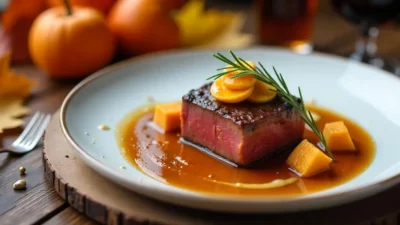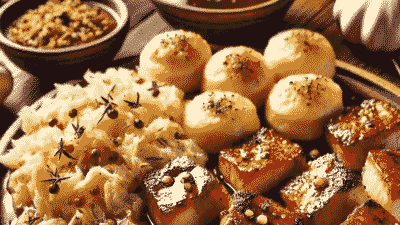Contents
A classic holiday dish from Norway, Pinnekjøtt is salt-cured lamb ribs, steamed over birch sticks until meltingly tender. Rich, salty, and perfect for Christmas Eve!
Ingredients
- 2 kg salt-cured and air-dried lamb ribs (Pinnekjøtt)
- 🌿 Birch sticks (or a steaming rack)
- 💧 Water (enough for steaming)Optional sides:
- 6 medium potatoes
- 🧈 Rutabaga mash (mashed swede or turnip)
- 🍷 Gløgg for serving
Instructions
- Soak the ribs: Rinse the pinnekjøtt under cold water. Then soak in clean water for 30–36 hours, changing the water every 8 hours. This removes excess salt.
- Prepare the steaming setup: Place birch sticks or a steaming rack in the bottom of a large pot. Add water just below the sticks’ level.
- Layer the meat: Arrange the ribs in layers on top of the sticks.
- Steam gently: Cover and steam on medium-low heat for 2.5 to 3 hours, until the meat is tender and starts falling off the bone.
- Crisp up (optional): For extra texture, place the ribs under a broiler for 5 minutes to lightly brown.
- Serve warm: Pair with rutabaga mash, potatoes, and gløgg for the full festive experience!

Notes
🇳🇴 Pinnekjøtt: Norway’s Salty, Steamy, and Totally Festive Christmas Lamb 🍖🌲
Softly salted, air-dried, and steamed over birch twigs — Pinnekjøtt is a holiday legend in Norway When the cold December nights creep in, Norwegians reach for something deeply traditional and utterly flavorful: Pinnekjøtt. This iconic Christmas lamb dish, literally named "stick meat" (because it’s steamed over sticks!), isn’t just food — it’s a full-blown culinary celebration handed down from Viking days to modern dining tables. 🛶✨🪵 But Why “Stick Meat”?
Good question. You’d think the Vikings could’ve picked a fancier name, right? 😄 But simplicity is part of the charm. Here’s what makes it special:- 🧂 Salt-cured lamb ribs – aged in brine, bold in flavor
- 🌬️ Air-dried outdoors – sometimes hung in garden sheds like edible laundry
- 🌿 Steamed over birch twigs – for an earthy, woodsy aroma
🎄 A Feast Fit for a Snowy Night
Pinnekjøtt isn’t just a dish — it’s Christmas Eve on a plate in many Norwegian households. Some even fight over whether it beats ribbe (crispy pork belly). Honestly? Why not both?! 😉Typical Pinnekjøtt Platter Includes:
- 🥔 Creamy rutabaga mash (kålrotstappe) – sweet, buttery, and balancing
- 🥖 Lutefisk, sausages, or glazed ham – the more, the merrier!
- 🍷 A mug of hot gløgg (spiced wine) – cheers to the season!






This Pinnekjøtt recipe sounds amazing! I’m excited to try it, but 30-36 hours of soaking seems like a long time. Is it really crucial to change the water every 8 hours, or could I get away with less frequent changes? I’m worried about accidentally making it too salty or too bland!